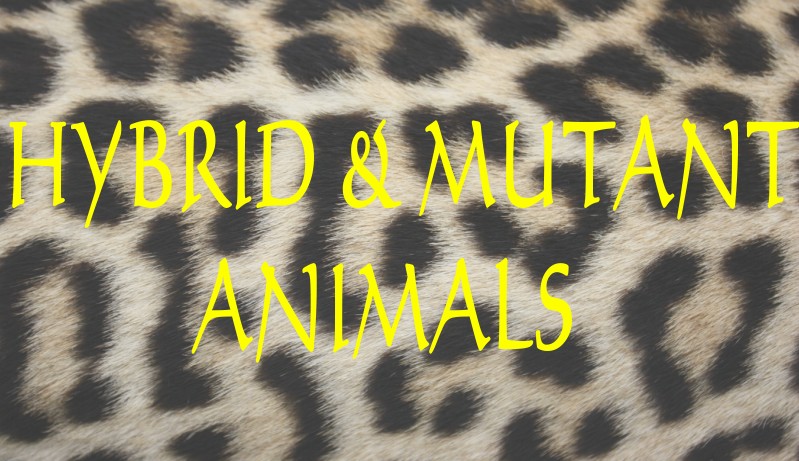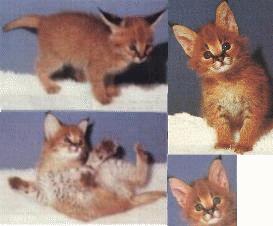
|
SERVAL AND CARACAL HYBRIDS |

SERVICAL
Servicals are the offspring of a male serval and female caracal. They occurred by accident when a Los Angeles zookeeper kept the two animals together. They were given to an animal shelter and no more was heard of them. The only available pictures show the Servicals as kittens. Their adult appearance is unknown, however there is renewed interest in cross-breeding Servals and Caracals for the exotic pet market.

CARAVAL (CARA-SERVAL)
The offspring of a caracal and serval is a caraval. Some call this hybrid a cara-serval. Caravals are now bred for the pet market. Due to restrictions on the keeping of lions etc, there is increased interest in hybrids of these smaller wild cats. Caracals are normally tawny in colour, but melanistic (black) caracals are not uncommon. Servals can also be melanistic (black) so it would be possible to breed black caravals. The Long Island Ocelot Club newsletter of May/June, 1999 described a 2-year old male caraval (caracal/serval hybrid) called Rahja weighing approximately 40 lbs and his sister, Tika.
In addition to the serval x caracal hybrid, I Kusminych and A Pawlowa reported a caracal/domestic hybrid cat at Moscow Zoo ("Ein Bastard von Karakal Hauskatze im Moskauer Zoo" in Der Zoologische Garten Vol. 68, No. 4 (1998)).
|
|
|
The Feline Conservation Federation Newsletter of Sept 2007 reported some servicals born in 1999 and 2001. The breeder, Denise Little, chose to call the hybrid a “ruka” (Swahili for “cross”) rather than the portmanteau name for this hybrid. Kiraka (female) and Tsavo (male) were born from Matata (serval male) and Cinnamon (caracal female) on October 18, 1999. Aki and Snuggles (both male) were born to the same parents on July 12, 2001. Being first cross hybrids, the appearance is variable. Kiraka had the stouter body and rounder head of a caracal, but with distinct dark spots on her body. Aki was smaller, with the long, lanky body and narrow face of a serval and lighter spots. In general, the hybrids had a reddish tan background colour and with dark brown spots on the body; some had smaller lighter spots while others had larger, darker spots. There are noticeable ear tufts, but these are shorter than those of the caracal. The backs of the ears had the white ocelli spots of the serval and the belly and inner legs were white with black stripes and spots. The paws and claws had a mix of caracal and serval traits. The tended to “chirp” at their owners.
CAR-CARAVAL, SER-CARAVAL & SER-SERVICAL
When a caraval is mated back to a serval the offspring are 75% serval and 25% caracal. They resemble the serval (left).
If a caraval was mated back to a caracal, the offspring would be more caracal-like - tawny, with fewer spots.

CARACAL/LYNX HYBRIDS
The 1997 LIOC cat census listed 3 hybrid cats of "Caracal/Lynx" type. However, purebred caracals are sometimes called "caracal lynxes" because of their tufted ears so these were probably not genuine hybrids. No such hybrids were reported on the 1998 survey, suggesting the earlier identification was an error based on terminology.
SERVAL/LYNX HYBRIDS
The Orlando Sentinel in 2004 reported Jana Londre of Boca Raton as having owned a caracal and a lynx-serval hybrid since 1992.
SERVEETAH
A serval/cheetah hybrid has been posited. Although both are long-legged cats, the size difference would probably prevent a mating.
REFERENCES AND FURTHER READING
For more information on the genetics of colour and pattern:
Robinson's Genetics for Cat Breeders & Veterinarians 4th Ed (the current version)
For more information on genetics, inheritance and gene pools see:
The Pros and Cons of Inbreeding
The Pros and Cons of Cloning
For more information on anomalous colour and pattern forms in big cats see
Karl Shuker's "Mystery Cats of the World" (Robert Hale: London, 1989 - some of the genetics content is outdated)
|
BACK TO HYBRID & MUTANT BIG CATS INDEX |